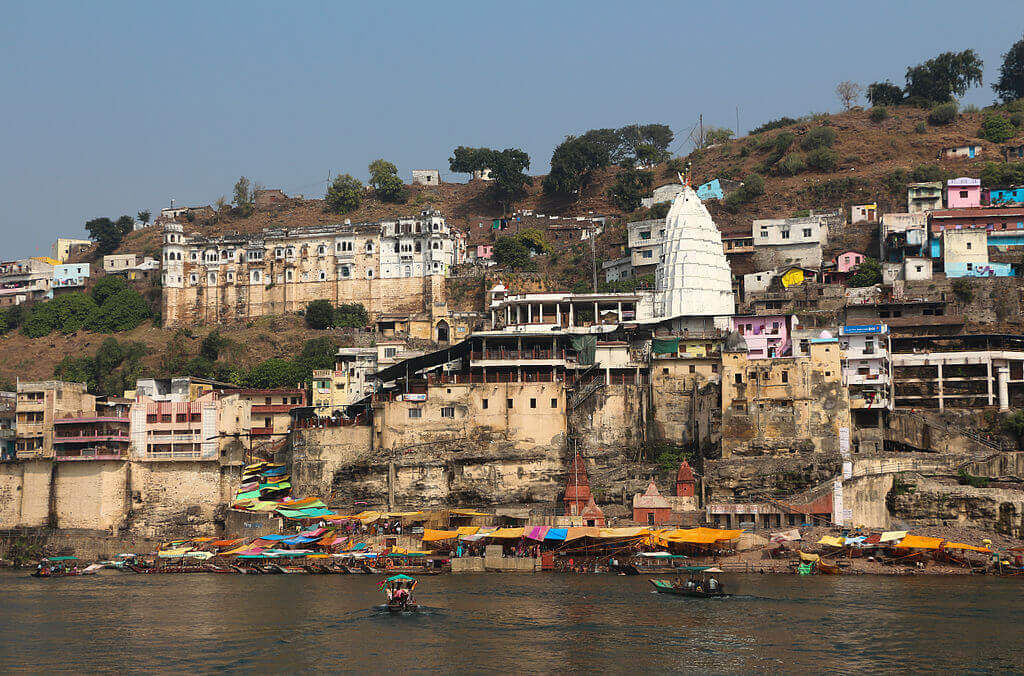The Temple of Omkareshwar

Omkareshwar which is situated on an island in the holy river Narmada. The place derives its name from the island which is shaped naturally like the sacred symbol ‘Om’ that adds to the divinity of the place. The island is also called Mandhata. It is named after the king Mandhata, an ancestor of Ram who ruled here in satyug. It was due to his devotion that Shiva decided to reside here.
There are two main Jyotirlinga temples in Omkareshwar. Both these temples, Omkareshwar and Mamaleshwar are considered equally sacred. The temples situated on either side of the river Narmada are connected by a cantilever bridge. The bridge is an attraction in itself for the tourists who stop here to capture the breadth- taking view of the river and the island.
The temple, built in Nagara style of architecture is a five- storeyed complex.
The temple of Omkareshwar Mahadev stands at the confluence of rivers Narmada and Kaveri (a tributary of Narmada). The visitors can reach there either by boat or walk over the bridge. The temple, built in Nagara style of architecture is a five- storey complex. There is a grand sabha-mandap(prayer hall) with pillars that are intricately carved. The main Jyotirlinga which is installed on the base floor remains immersed in water. The lingam here is in the form of a rock on which constantly water is offered. The significance of this lingam is that it is not below the shikhar. Behind the Shivling is the image of Parvati in silver. The puja is held thrice a day. Interestingly, the morning puja is done by the temple trust, the day puja is held by the priests of Scindias, and evening by the Holkar Priests. It is believed that Lord Shiva and Ma Parvati come here to relax at night. Thus, after the Shayan aarti the priests lay a bed in front of the Shivling. A game of chaupad (ancient ludo) is placed for them to play. The other floors have the idols of Mahakaleshwar, Siddhanath, Gupteshwar and Dhwajeshwar.
Omkareshwar is the first Jyotirlinga visited by Adi Guru Shankaracharya. He met Guru Govind Bhagvat who lived in a cave near the entrance of the temple. Shankaracharya received the knowledge of philosophy here.
Behind the temple lies the beautiful Mandhata palace, a part of which is open to the public. One has to go up a number of steps to reach the palace The marvellous view of the temple and the river below from the carved jharokhas of the palace is worth the effort. There are many other temples on the island which can be seen during the Parikrama of the island. Alternatively, you can do this parikrama by boat which takes about two hours in the holy river Narmada and experience the scenic beauty of the Sangam and the vindhya mountains around the island.
On the southern bank, lies the Mamleshwar Shiv Temple which is located in a beautiful walled complex along with seven other small temples. The temple complex has an old world charm. When you walk around the temple you are transported back in time surrounded by mighty stone walls with carved sculptures. There is a nandi mandap outside the main temple. It is said the pilgrimage is not complete without visiting this temple.
Omkareshwar is called as the Nabhi Sthal (navel) of river Narmada. It lies strategically midway between the path of Narmada from its source at Amarkantaka (Madhya pradesh) To its final destination near Bharuch (Gujarat) in the Arabian sea.
Omkareshwar is about 160 Km. from Ujjain where the famous Mahakaleshwar jyotirlinga is located. The devotees can visit both the places in one trip.